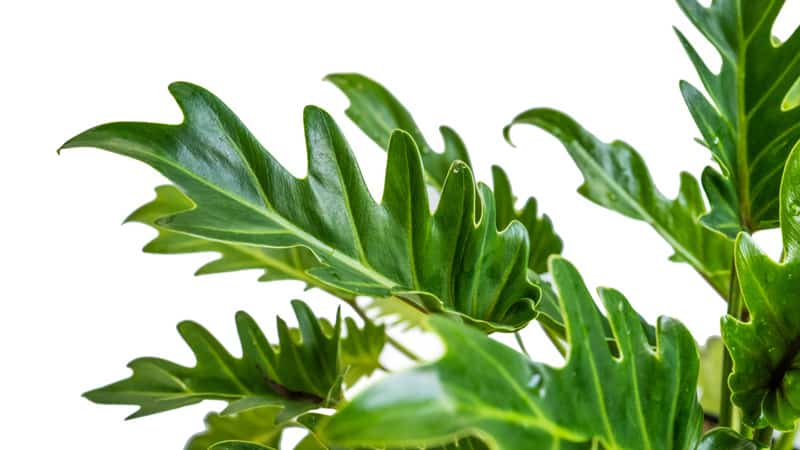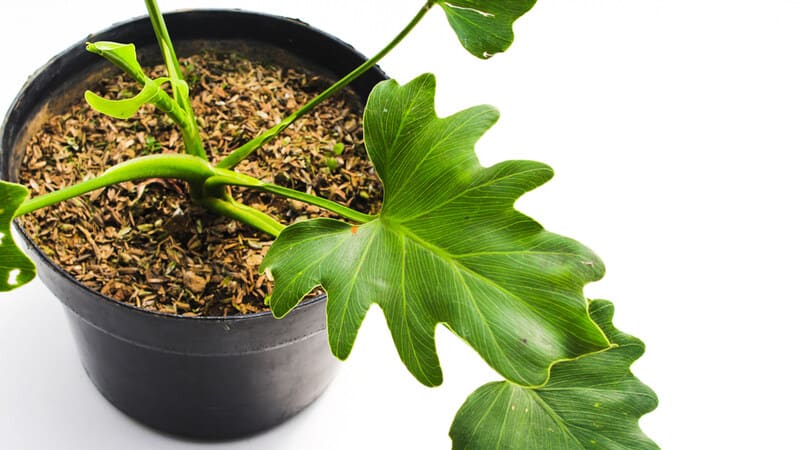Philodendrons are the trending houseplant of the moment, with the Philodendron Selloum being a particular crowd favourite. Just take a look at this variety’s dramatic foliage to see why you need one.
The Selloum is known for its huge, sturdy green stems that hold wide, lobed dark green leaves. It also goes by its other names — Philodendron Bipinnatifidum (which translates to ‘double, feathery split leaves’) and Horsehead Philodendron.
The good news is, you can keep your Selloum indoors or outdoors. Just be sure to give it enough space to grow — this variety isn’t called Tree Philodendron for nothing.
Whichever location you choose for your plant, the Philodendron Selloum will certainly brighten up your space with its dazzling form.
An overview of the Philodendron Selloum

Don’t be surprised if you won’t be able to take your eyes off of the stunning Philodendron Selloum.
Its impressive size, deep green leaves, and vigorous vining nature make for a captivating plant that’s Insta-worthy.
Even better, this variety bears edible fruit. The Philodendron Bipinnatifidum’s fruit can be cooked and used in compotes.
You may be wondering how this is so, considering that most Philodendrons are toxic.
Philodendrons contain a chemical compound in the form of calcium oxalate crystals, which is toxic to humans and pets if ingested.
Cooking or drying the plant thoroughly, however, breaks down the crystalline structure of the toxin, making the plant safe to eat.
A healthy and fully mature Selloum can grow up to 3.6m tall outdoors, with leaves reaching up to 1.5m long.
It’s one of the biggest Philodendrons around! Because of its towering structure, the Selloum has earned the nickname Tree Philodendron or Tree Selloum. When indoors, this variety won’t grow to be as huge as its outdoor counterpart.
You can opt for the Philodendron Selloum Compacta if you’re keen on collecting smaller Selloum cultivars.
As its name suggests, this compact Philodendron grows up to 1m tall and makes for an ideal indoor houseplant.
Another attractive cultivar of this variety is the Philodendron Bipinnatifidum Tortum. The Tortum has thin, lance-like leaves and looks more similar to a palm plant.
If you’re looking to add interest to smaller spaces, the petite Philodendron Selloum Super Atom is a great choice.
Its tiny shrub-like stature and robust leafy form make it easier to position in cramped interiors. With a height of only 30cm, it can smoothly fit in a bookshelf or atop an office desk.
How to tell the difference between a Philodendron Selloum and other varieties
There are a lot of Philodendron varieties out there, and some may even look the same at first glance!
Know the difference between the Philodendron Selloum and other similar-looking Philodendron species with this quick guide:
Philodendron Xanadu vs Philodendron Selloum

When you look at photos of Philodendron Xanadu and Selloum, it can be easy to mistake one for the other.
Both have lobed shiny leaves that fan out into finger-like extensions.
But if you examine closely, there are slight differences in the shape and size of the Xanadu and Selloum varieties.
For one, a Xanadu’s leaves are flatter and less wavy. The leaf tips are also rounder compared to the Selloum, which has more angular and spear-shaped foliage.
When it comes to leaf size, the Selloum wins hands down. The Tree Philodendron is known for having some of the largest leaves in the Philodendron family.
The sheer size of the Selloum will instantly spruce up a blank wall, porch, or balcony.
The Xanadu, on the other hand, is the smaller Philodendron between the two varieties. It has leaves that only grow up to 40cm long, making it perfect as an indoor decorative plant.
You can also spot the difference between a Xanadu and Selloum in their growth patterns.
A Xanadu’s stems grow alternately, giving the appearance of randomly-growing foliage.
A Selloum grows its stems in a spiral-like direction, which makes for a lush and more robust presentation.
Philodendron Hope vs Philodendron Selloum
The Philodendron Selloum is supersized and needs ample space for growth.
The Philodendron Hope, on the other hand, can easily fit into tinier spaces. If a smaller sort of the Selloum variety is more your speed, then the Philodendron Hope is the ideal houseplant for you.
Indoors, it can reach up to 1.2m tall. It’s not too big, not too small — just right, I would say.
Like the Selloum, the Philodendron Hope has a low-maintenance nature. Simply water, prune, and fertilise as needed. Extra doting is optional.
Philodendron Selloum plant care
For proper Philodendron Bipinnatifidum care, it will help to familiarise yourself with your plant’s growth habits and environmental conditions. This will definitely make a difference when attending to your plant’s needs.
That said, this gentle giant is a low-maintenance houseplant. You will undoubtedly enjoy being a plant parent to this variety.
To successfully grow a Philodendron Selloum at home, you need bright, indirect sunlight, regulated temperature, and a humid environment. Water, fertilise and prune as needed.
These simple steps will show you how:
Give it bright, indirect light

As with most Philodendron varieties, the Selloum needs plenty of bright, indirect sunlight. Place your plant near a window for ample lighting.
Take care that the leaves are shaded from direct sun — the sun’s rays can burn the foliage of your Philodendron and result in permanent leaf damage.
Excessive bright light can also cause pale-looking leaves.
Pro tip: Philodendron leaves are known to grow towards the direction of their light source. Rotate your plant regularly to ensure that all the foliage can catch light sufficiently. Cleaning your Selloum’s leaves when they get dusty also increases their chances of photosynthesis.
Use enriched, well-draining soil
For a healthy and robust-looking Philodendron Selloum, plant it in moist, well-draining soil that has been enriched with organic matter.
Gardening experts recommend a ratio of equal parts compost, perlite, and orchid bark or coco coir. Check for soil acidity as well.
This variety prefers slightly alkaline soils over acidic or salty soil.
Water to keep the soil moist

The Philodendron Selloum typically likes moist but not soggy soil. Unlike most Philodendrons, however, it doesn’t like standing in dry soil in between waterings.
A regular watering once a week is usually enough to keep your Selloum well hydrated. Make sure to slowly water the area where the central roots are.
Let your Philodendron’s root ball take its sweet time absorbing the moisture. This will allow your plant to soak in water efficiently without getting waterlogged.
Distilled water is the best liquid to use on your plant. Water that has passed through a water softener has been treated and lacks the necessary nutrients to nourish your plant.
Inasmuch as you adore your plant baby, avoid overwatering at all costs. Watering too much and too frequently causes root rot. A Philodendron Selloum with yellow leaves is also a sign of overwatering.
Pro tip: Don’t know when to water? Stick your finger half about 1cm into the soil to test the moisture level. Soil that has excess water will feel soggy. The right soil consistency is moist but not drenched.
Regulate the temperature and humidity

Just like its other Philodendron cousins, the Philodendron Selloum thrives in warm, humid conditions.
It is a South American native plant, after all, and is well-acclimated in an environment that is similar to a rainforest. A room temperature of 250C is just about right for your Philodendron.
Take care not to position your plant near heating vents or air conditioning. The Selloum won’t do well in extreme temperatures.
Because of its sturdy size, however, it can withstand wind when placed outdoors.
Pro tip: Is the air conditioning in your home drying your Philodendron out? No worries — we have an easy solution for you.
The quickest way to rehydrate your Philodendron Bipinnatifidum is to put it in your bathroom. Your plant will absorb the moisture in its surroundings and plump back up in no time.
You can also place it on top of a pebble tray moistened with water to mimic a humid environment. Another trick to increase the humidity is to group your Selloum together with other houseplants.
Fertilise monthly
A well-nourished Philodendron is resistant to plant diseases. Feed your Selloum once a month with a diluted balanced fertiliser to ensure it stays vital and healthy.
You can also fertilise your plant baby during growth season to boost its development.
Pro tip: Take care not to over-fertilise your plant. Too much plant food can cause your Selloum’s leaves to turn brown.
Giving your plant water that has passed through a water softener is another possible explanation for browning leaves.
Prune as needed
Pruning a Selloum is done mainly to manage its shape and size. Use clean scissors or shears, and cut at the base of the stem.
Remove infected leaves while you’re at it. Doing so will reserve much-needed nutrients for healthier parts of the plant.
How to propagate Philodendron Selloum

Want to grow your own Bipinnatifidum variety at home? Philodendron Bipinnatifidum propagation is a no-fuss process.
These are the tools you need:
- Philodendron Selloum plant
- Clean, sharp scissors or pruners
- Jar
- Clean water
- Potting medium
Propagation of Philodendron Selloum in water
With just a few simple steps, you can successfully propagate a Philodendron Selloum, even if you’re only a beginner gardener.
Step 1. Cut below the node
Cut right below the node of the Philodendron Selloum stem. You can do this during one of your pruning sessions.
Check that the stem has at least 2-3 leaves and several nodes.
Step 2. Place in water
Place the Philodendron Bipinnatifidum cutting in a jar of water.
Position the jar in an area where there is bright, indirect sunlight.
Step 3. Give it clean water regularly
For a successful Philodendron Selloum propagation, change the water every week or as soon as it looks murky (whichever comes first).
In a matter of weeks, roots will start to form in your cutting.
Step 4. Plant in a well-draining planting mix
Transfer your cutting to a pot or planting site with a well-draining potting medium as soon as the roots become 2.5-5cm long.
Have healthy Philodendron houseplants all year round
When you’re looking for size and spectacle, the Selloum is the Philodendron to pick.
Plant one or as many as you want in your garden — this variety is built for large-scale splendour.
Keeping your humongous Selloum plants in tiptop condition can be tiresome if you have a busy schedule, however.
A convenient way to keep your Philodendrons healthy all year round is to hire your local gardening service.
With professional gardeners taking care of your houseplants, you can be sure that your plant babies are maintained well and tended to regularly.
Even better, you get to have beautiful Philodendrons without having to worry about regular watering and such — easy peasy!

